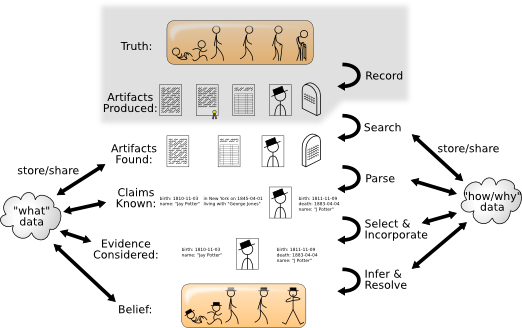
Being an illustration and a discussion thereof.
Last week I posted only a poem because I spent my writing time working on documenting the emerging polygenea data model instead. At least in part this is because attending RootsTech RootsTech itself, not any presentation therein. The environment inspired me to unusually focused thought on the matter. helped me see my way around its remaining problems; but, whatever the reason, my mind is still dwelling on genealogy now.
For one of my talks in RootsTech I really wanted a picture, a single image, that showed what genealogical research is. I knew and liked Joe Matel’s genealogical workflow model The link to the workflow model PDF kept moving, so I currently host my own copy. Joe, if you read this and would like me to take it down let me know. and had used Mark Tucker’s genealogy research process map before, but neither of them really hit at what I wanted to get across. So I made my own.

The first point I wanted to make with this picture was what the basic steps are in research (search, parse, select, incorporate, infer, resolve). This is not a set I see mentioned very often. You don’t have to tell people to parse a record, for example; give them a document and they will try to parse what it says on their own. But you are doing it, consciously or not, and since you are doing it it can result in mistakes and disagreements.
I also wanted to emphasize that there was a difference between sharing what you did and what it resulted in. Most people seem to think only about the results, which is fair: they are the inputs to the next step and thus have more immediate value. But it is not the results that cause disagreements, it is the steps used to get to them. I wanted the image to make clear the difference between those two ideas.
I wanted to include error with every step. Not all of them fit into the picture, but I did have the search turns up the wrong headstone, removed some documents during the search and select steps, and made the wrong inference about the person’s appearance. The end result is a belief that does not resemble reality very closely. This might not be the most common case, but it is wise to act on the assumption that it is the most common case. Thinking your past research is infallible can got it right can lead you astray in the future.
There are other points to make about this picture. Every arrow has a cost in researcher effort, for example. It takes effort to record what you are doing and it takes effort to understand what you recorded. But it also takes effort to re-derive your inferences based on the evidence you considered and the resulting belief. You can’t get around doing some work if you want to do research. I have also used it as a catalyst for conversations about how to record your own life, how to come to an agreement with someone who disagrees with you, how you should treat things like pictures and anecdotes, etc.
They say a picture is worth some large number of words. They also say that hindsight is 20/20, that stewed cranberries taste more like prunes than rhubarb, and all sorts of other hard-to-substantiate things; but I do rather like this image. I hope others find it useful as well.
Looking for comments…